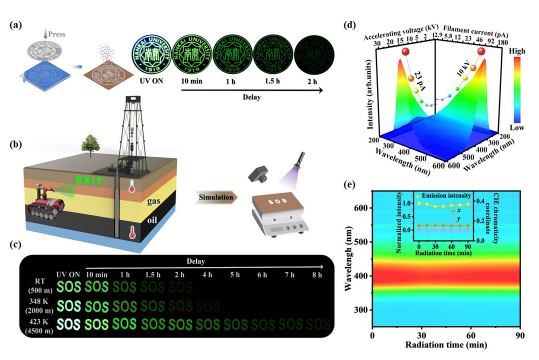NKU Team Makes Important Progress on Constructing Novel Optoelectronic Materials by Defect Control
Recently, an important progress was made by the research group led by Wu Li and Kong Yongfa from the team led by Professor Xu Jingjun from the School of Physics at Nankai University. A high temperature long persistent luminescence (HT-LPL) material with a duration time of more than 8 hours at 423 K was sucesssfully prepared by constructing quasi-continuous defect levels. The relevant results are titled Quasi-Continuous Defect Levels in Broadband Gap: A New Strategy for High Temperature Long Persistent Luminescence Materials and published in the well-known journal Advanced Optical Materials.
Optoelectronic functional materials have important applications in the fields of lighting, display, detection, anti-counterfeiting, etc. The conventional research starts from the classical system and uses the trial-and-error method to select the required high-performance new materials from a large number of candidates. It faces the challenges of insufficient accuracy and low efficiency, which limits the R & D of advanced materials. Starting from the defects, the team has been investigating photoelectric conversion characteristics of functional materials for many years for the purpose of developing new photoelectric materials. They not only realized the ‘zero thermal quenching’ of luminescent materials (Adv. Opt. Mater. 2021, 2100870) and extended the research system of elastico-mechanoluminescent materials (J. Mater. Chem. C 2019, 7, 7096; 2021, 9, 3513), but also overcame the limitation that the self-reduction of aliovalence ions can be realized only in a matrix containing XO4 groups. In the borate host containing only planar BO3 groups, the self-reduction from Mn4+ to Mn2+ in ambient atmosphere is realized. It reveals that the key to the self-reduction is the lattice defects introducted during doping and preparation, but not a special matrix structure. The result deepens our understanding of the self-reduction mechanism and further clarifies the important role of lattice defects in the preparation and performance optimization of optoelectronic materials (Adv. Opt. Mater. 2023, 2300515.).
Considering of the regulation of defect levels at different depths on the luminescence, they proposed a strategy of forming quasi-continuous defect levels in broad band gap to avoid rapid degradation of the performance of LPL materials at a high temperature. They successfully prepared a high-temperature LPL material with a duration time of more than 8 hours at 423 K. The excellent LPL material can be used in emergency lighting and warning devices for extreme conditions such as deep well exploration at a depth of 4,500 m. The intense anti-degradation blue cathodoluminescence (CL) makes it suitable for field emission displays, while the manipulable emission property makes it suitable for high-level anti-counterfeiting. So it is a composite functional material that has multiple functions.

Figure: (a) Room-temperature LPL of the Nankai University emblem sample in 2 hours; (b) The underground temperature of deep well exploration simulated in the laboratory; (c) The change of LPL for SOS signal with temperature/depth, which was still visible to the naked eye after about 8 hours at a depth of 4,500 m; (d) The CL spectrum under different filament currents and acceleration voltages, which did not reach saturation in the test range; (e) The variation of CL spectra with the electron beam irradiation time (a intensity decrease of only 10% in 90 minutes), and the CIE coordinates remained almost unchanged.
Doctoral student Zhang Pan from Nankai University is the first author. Professor Wu Li and Associate Professor Sun Tongqing from Nankai University and Professor Wang Yuhua from Lanzhou University are co-corresponding authors. Nankai University is the first completion unit.
Article Link: https://doi.org/10.1002/adom.202301406.









